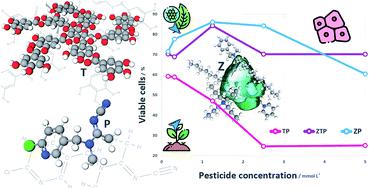当前位置:
X-MOL 学术
›
Environ. Sci.: Processes Impacts
›
论文详情
Our official English website, www.x-mol.net, welcomes your
feedback! (Note: you will need to create a separate account there.)
Modulation of cytotoxicity by consecutive adsorption of tannic acid and pesticides on surfactant functionalized zeolites.
Environmental Science: Processes & Impacts ( IF 4.3 ) Pub Date : 2020-08-28 , DOI: 10.1039/d0em00251h Anka Jevremović 1 , Nevena BoŽinović , Dragana Arsenijević , Sanal Marmakov , Bojana Nedić Vasiljević , SneŽana Uskoković-Marković , Danica Bajuk-Bogdanović , Maja Milojević-Rakić
Environmental Science: Processes & Impacts ( IF 4.3 ) Pub Date : 2020-08-28 , DOI: 10.1039/d0em00251h Anka Jevremović 1 , Nevena BoŽinović , Dragana Arsenijević , Sanal Marmakov , Bojana Nedić Vasiljević , SneŽana Uskoković-Marković , Danica Bajuk-Bogdanović , Maja Milojević-Rakić
Affiliation

|
This study investigated the environmental application of FAU type zeolites modified with cationic surfactants (cetylpyridinium chloride, tetrapropylammonium chloride and benzalkonium chloride). Adsorbent characterization was conducted using Fourier-transform infrared and Raman spectroscopy, thermogravimetry and differential thermal analysis, atomic force microscopy and X-ray powder diffraction. The efficiency for tannic acid adsorption from aqueous solution on the surface of prepared composites is studied and the adsorption process was modelled with different isotherm equations. Surfactant modifications of zeolites led to improved adsorption properties compared to FAU zeolites alone. The proposed mechanism controlling the adsorption of tannic acid onto surfactant modified zeolites mainly relies on π–π and hydrophobic interactions. The investigated materials are promising adsorbents for tannic acid and similar phenolics and may be important for environmental and dietary aspects of polyphenol persistence and usage. Further on, functionalized zeolites were studied for insecticide acetamiprid removal, prior to and after tannic acid retention. Promising findings of insecticide co-adsorption with tannic acid led to cytotoxicity evaluation. The cytotoxicity modulation effect of zeolites and tannic acid on acetamiprid points to the essential role of both components in insecticide toxicity reduction.
中文翻译:

通过单宁酸和农药在表面活性剂官能化沸石上的连续吸附来调节细胞毒性。
这项研究调查了用阳离子表面活性剂(氯化十六烷基吡啶,氯化四丙基铵和氯化苄基铵)改性的FAU型沸石在环境中的应用。使用傅里叶变换红外和拉曼光谱,热重分析和差热分析,原子力显微镜和X射线粉末衍射对吸附剂进行表征。研究了制备的复合材料表面上单宁酸从水溶液中的吸附效率,并用不同的等温方程对吸附过程进行了建模。与单独的FAU沸石相比,表面活性剂对沸石的改性导致吸附性能的提高。提出的控制单宁酸在表面活性剂改性沸石上的吸附机理主要取决于π-π和疏水相互作用。研究的材料是单宁酸和类似酚类的有前途的吸附剂,对于多酚的持久性和使用环境和饮食方面可能很重要。此外,在保留单宁酸之前和之后,对功能化沸石进行了杀虫剂乙酰胺的去除研究。杀虫剂与鞣酸共吸附的有前途的发现导致细胞毒性评估。沸石和丹宁酸对乙酰胺的细胞毒性调节作用表明这两种成分在减少杀虫剂毒性方面均具有重要作用。单宁酸保留之前和之后。杀虫剂与鞣酸共吸附的有前途的发现导致细胞毒性评估。沸石和丹宁酸对乙酰胺的细胞毒性调节作用表明这两种成分在减少杀虫剂毒性方面均具有重要作用。单宁酸保留之前和之后。杀虫剂与鞣酸共吸附的有前途的发现导致细胞毒性评估。沸石和丹宁酸对乙酰胺的细胞毒性调节作用表明这两种成分在减少杀虫剂毒性方面都起着至关重要的作用。
更新日期:2020-11-03
中文翻译:

通过单宁酸和农药在表面活性剂官能化沸石上的连续吸附来调节细胞毒性。
这项研究调查了用阳离子表面活性剂(氯化十六烷基吡啶,氯化四丙基铵和氯化苄基铵)改性的FAU型沸石在环境中的应用。使用傅里叶变换红外和拉曼光谱,热重分析和差热分析,原子力显微镜和X射线粉末衍射对吸附剂进行表征。研究了制备的复合材料表面上单宁酸从水溶液中的吸附效率,并用不同的等温方程对吸附过程进行了建模。与单独的FAU沸石相比,表面活性剂对沸石的改性导致吸附性能的提高。提出的控制单宁酸在表面活性剂改性沸石上的吸附机理主要取决于π-π和疏水相互作用。研究的材料是单宁酸和类似酚类的有前途的吸附剂,对于多酚的持久性和使用环境和饮食方面可能很重要。此外,在保留单宁酸之前和之后,对功能化沸石进行了杀虫剂乙酰胺的去除研究。杀虫剂与鞣酸共吸附的有前途的发现导致细胞毒性评估。沸石和丹宁酸对乙酰胺的细胞毒性调节作用表明这两种成分在减少杀虫剂毒性方面均具有重要作用。单宁酸保留之前和之后。杀虫剂与鞣酸共吸附的有前途的发现导致细胞毒性评估。沸石和丹宁酸对乙酰胺的细胞毒性调节作用表明这两种成分在减少杀虫剂毒性方面均具有重要作用。单宁酸保留之前和之后。杀虫剂与鞣酸共吸附的有前途的发现导致细胞毒性评估。沸石和丹宁酸对乙酰胺的细胞毒性调节作用表明这两种成分在减少杀虫剂毒性方面都起着至关重要的作用。











































 京公网安备 11010802027423号
京公网安备 11010802027423号